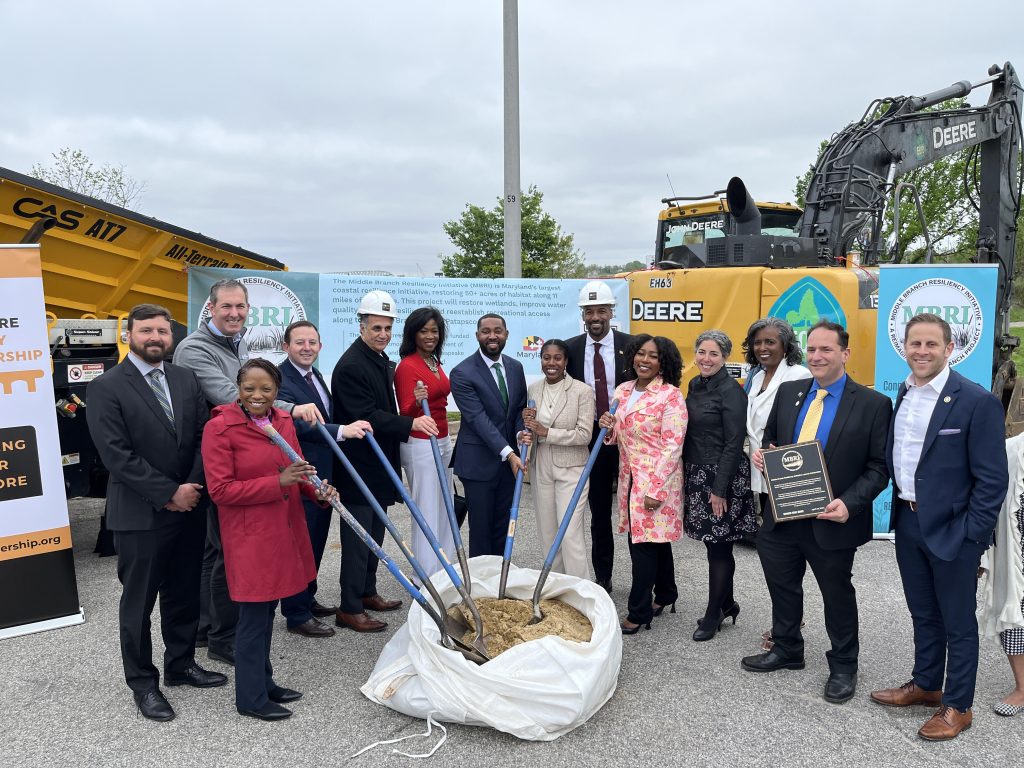Secretary’s Message: Maryland is Stronger with Planned Climate Resilience

Ground is broken for the Hanover Street Wetlands, part of the Middle Branch Resilience Initiative, which is adding wetlands, natural shorelines, boardwalks, and fishing areas in South Baltimore. Maryland Department of Natural Resources photo.
The recent dry spell notwithstanding, the Atlantic hurricane season is underway. NOAA National Weather Service forecasters’ outlook for the 2024 Atlantic hurricane season, which spans from June 1 to November 30, predicted an 85% chance of an above-normal hurricane activity in the Atlantic basin this year.
Maryland’s 3,190 miles of shoreline – including land abutting its rivers, bays, and the Atlantic coast – have always put us in the crosshairs of flooding from major storms and events. We don’t even need to suffer a direct hit, as we regularly suffer flooding from storm surges and “sunny day flooding” caused when exceptionally high tide breaches the land. Climate change, sea level rise, erosion, and subsidence all are working against us to make this problem worse unless we act.
In Maryland, we are continually developing the tools of resilience, combined efforts to identify and protect our lands and communities from flooding and extreme weather. Through the Maryland Commission on Climate Change’s Adaptation and Resiliency Work Group, the state developed the Next Generation Adaptation Plan that will guide adaptation actions over the next 10 years. You will read more about this plan in the coming months.
Governor Wes Moore recently signed a climate executive order, which formed a climate sub-cabinet to ensure coordinated action on the Climate Pollution Reduction Plan managed by our sister agency, the Maryland Department of the Environment.
Through legislation, Maryland has established an Office of Resilience, tasked with developing a statewide strategy for adapting to these threats and even include plans like cyber and food security as well). Last year, the Maryland Department of Natural Resources hired its first ever Resilient Systems Officer, Jackie Specht, who is coordinating the agency’s efforts to identify and protect vulnerable areas.
The Great Maryland Outdoors Act provided $5 million to support actions such as the use of nature-based solutions to reduce climate impacts, or the moving and elevating of infrastructure. The Department of Natural Resources, which manages about 600,000 acres of public lands, is developing a strategy to put these funds into action.
An important element of these efforts is the ongoing project to plant 5 Million Trees by 2031, especially plantings in urban landscapes, which will support the reduction of heat islands and improved water quality.
DNR continues to monitor and work with our communities to put localized plans in place. The department last week announced more than $2.9 million in competitive grants for 12 climate resilience projects to help communities design and construct solutions to withstand flooding and other weather-related events. The selected projects will reduce risk for vulnerable communities, incorporate climate change data into existing plans and policies, and develop nature-based or natural solutions to help control flooding.
Recently, I also had the pleasure of helping to kick off the Middle Branch Resiliency Initiative that will add wetlands, natural shorelines, boardwalks, and fishing areas in South Baltimore–an urban area long affected by pollution that previously had little public access to waterways. In Anne Arundel County in May, I joined with Arundel Rivers and community members to celebrate the completion of the Franklin Point State Park living shoreline, a project that has stopped the long-term erosion of the shoreline at the park and the nearby Columbia Beach community. Both of these projects are models of coastal resilience that DNR aims to emulate through other efforts and partnerships around the state.
The threat of flooding and our efforts to mitigate it affects everyone in Maryland, not just those who live on the coast. Jobs, recreation, transportation, and communities throughout the state are at risk. By working together we will ride out the storm and keep Maryland resilient!
Josh Kurtz is Secretary of the Maryland Department of Natural Resources.
